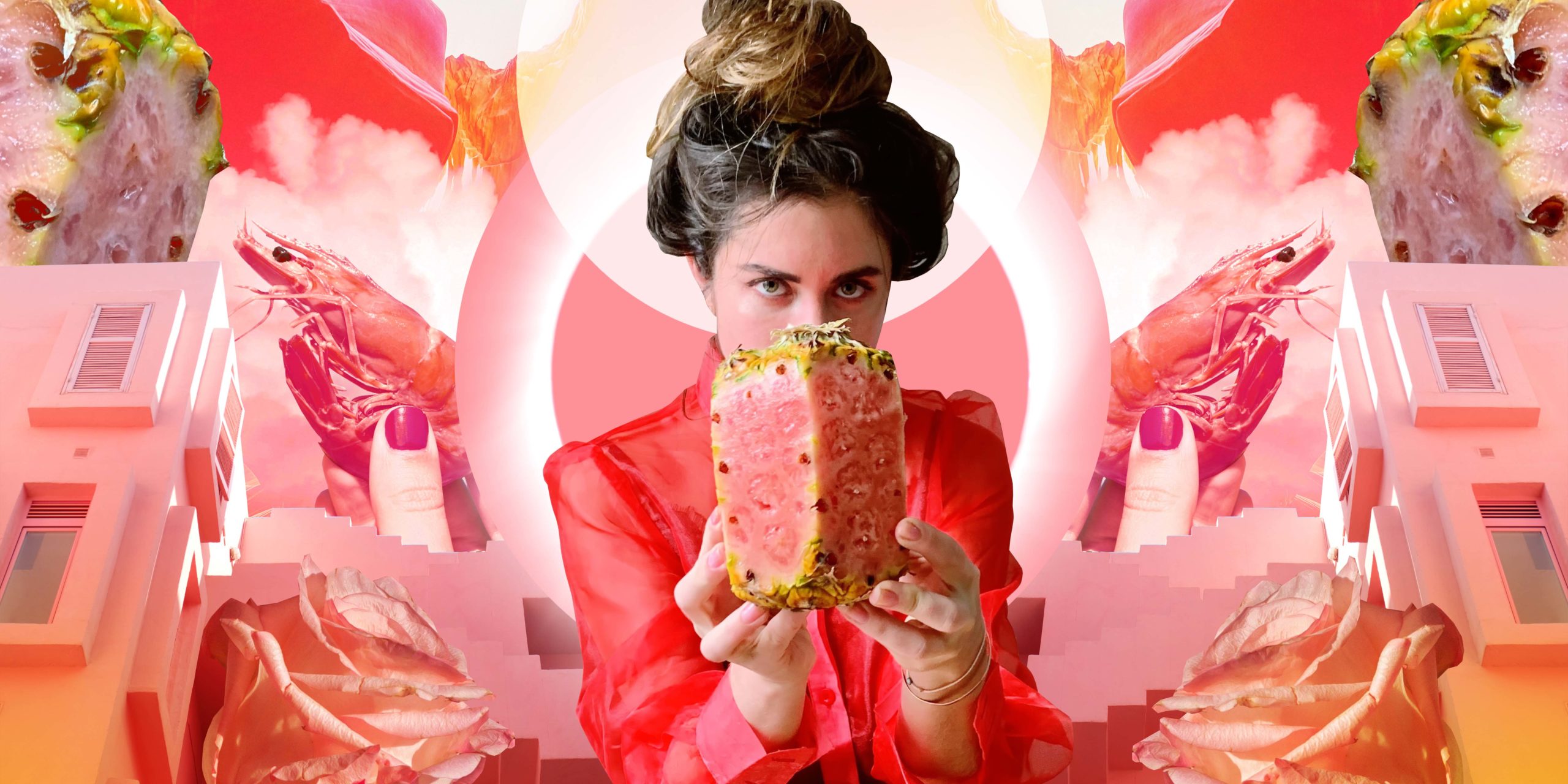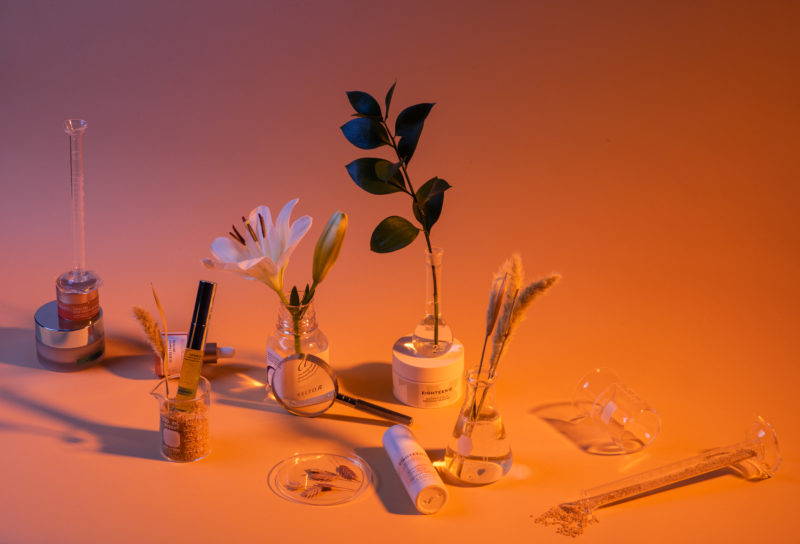We’ll begin with the color. This is not a bubblegum pink, nor is it a sultry magenta or a coy blush. The exact hue of Del Monte’s newly introduced pink pineapple is more of a peony-cantaloupe blend — a color I’ve seen on polo shirts in Cape Cod and on the lips of actresses in midcentury Douglas Sirk films. If I were a professional color-namer (and perhaps I should be), I’d call it “Teenage Shrimp.” This is what you get when you tinker with Ananas comosu’s DNA to decrease levels of enzymes that convert lycopene into beta carotene. With less conversion, the pineapple’s classic sunny hue becomes…5R 7/6.
That artfully-designated hue, listed on Del Monte’s patent application, comes from the Munsell Color Chart, a system developed in the early 20th century by an artist who sought to create a scientific method of color notation. In its documentation of the fruit’s 15-year journey from idea to reality, Del Monte also calls its creation “Rosé”, or “Extra Sweet Pink Flesh Pineapple” — and if you order a $49 specimen from the company’s direct-to-consumer pineapple portal, you’ll discover that its official name, complete with a trademark, is the Pinkglow™.
At this point in human history, whole swaths of consumer goods have been engineered (or re-engineered) to draw covetous eyes and tapping fingers on social media. Book covers are designed with larger cover typography, all the better to show up well in an iPhone-sized grid. “Instagram makeup” is a category unto itself, with products designed specifically to translate spectacularly in photos, no matter how bizarre or clownish they might appear on real-life faces. And now, perhaps inevitably, there is Instagram Fruit. As soon as the Pinkglow™ became available, it popped up on influencer feeds attached to ready-made hashtags like #beingpinkglow and #jewelofthejungle. In one photo, a male model with sizzling cheekbones holds up a slice of gleaming fruit with a perfect bite extracted from it. “Don’t Worry About a Filter,” the Pinkglow™ website tells us. “We Grew It.”
Damn right they did. Scientists have been editing crop DNA since the 1980s: sometimes to increase a food’s vitamin content; sometimes for disease resistance or a longer shelf life, or to make a food less likely to turn brown from oxygen exposure. Del Monte doesn’t hide that its pineapple is the result of human intervention, but it doesn’t exactly advertise it either: the words “genetically modified” do not currently appear anywhere on the Pinkglow™. But regardless of where you sit on the spectrum between “GMO’d foods are evil” and “GMO’d foods are awesome,” it is impossible not to be impressed by the sheer marshaling of resources required for a company to spend more than a decade in pursuit of an edible meme.
Not surprisingly, Del Monte has pulled out all of the branding stops. Each pineapple arrives with a gold-sealed certificate of authenticity congratulating the recipient on “obtaining this royal delicacy” and a helpful reminder to “tag #PinkGlowPineapple and watch the likes pour in.” The fruit’s crown is lopped off before shipping, which means that it looks less like a pineapple upon arrival than a quilted football nestled in tissue paper. An FAQ on the website explains the crown-severing like so: “Pinkglow™ Pineapples are harvested by hand. In order to regenerate new pineapple crops, the crown needs to be planted.” This is surely true, but Del Monte is eliding a second, and possibly more important, reason for the decapitation. With a crown in hand, it wouldn’t be impossible for a home gardener in an appropriate climate to propagate — or “pirate” — the proprietary fruit. Receiving a topless pineapple does, of course, rob the fruit of its kingly silhouette… but trade secrets are trade secrets. I contacted Del Monte to find out if someone could confirm my hunch about the missing crown, but the company was unresponsive. I located a subtext in this: The pink pineapple isn’t a dialogue; it’s a statement.
And how does it taste? What looks at first like a purely cosmetic alteration — lip injections for a fruit — also has flavor implications. The Pinkglow™ has an almost supernatural sugary effulgence. It is sweet enough that my carefully-sliced squares tasted much better once a little lime juice was sprinkled on top. This, I realized while munching, was an addition not required by normal pineapples. Still, when served ice-cold in a glass bowl on a winter morning, the fruit had undeniable charisma.
It is true that I am remarkably susceptible to the charms of novelty food experiences. Hunting down and eating new fruits makes me feel alive in a way that other boring hobbies can’t touch. I will always remember the day (December 8, 2018) that I first tasted a borojo in a Costa Rican orchard near the Panama border. The borojo tasted like mulled wine and looked like a baseball that someone had buried underground for 200 years; its texture I can only compare to triple-crème Brie. I dream of monstera deliciosa: the fruit that looks like an ogre’s bunion and smells like strawberry-guava pudding. Or diospyros nigra, the black sapote, which tastes like licking date paste off a stone. A source of regular consternation is the fact that I still haven’t managed to track down a medlar — a curious brown orb that must be bletted, or aged to the point of near-rottenness, before it can be eaten. Apparently they were huge in the Middle Ages.
Any outfit that wishes to sell genetically engineered food in America is encouraged to enter a voluntary consultation with the FDA, with results that are published online for all to see. Del Monte submitted information about their new pineapple — which was referred to, with a certain science fiction flair, as “transformation event number EF2-114” — in 2015. The FDA reviewed the documents, agreed that pink pineapples were nutritionally comparable to normal pineapples, confirmed that Del Monte’s proposed description was accurate, and gave the fruit their understated blessing, concluding that the Pinkglow™ is “as safe as conventional pineapple varieties for its intended uses in human food.”
Two of the most prominent GMO fruit-interventions have also involved tropical fruits. Cavendish bananas — the kind you slice into coins over your morning cereal and whiz into smoothies — have fallen victim to TR4, a fungus that threatens to implode the world’s banana supply chain. In 2012, Australian scientists inserted a gene for TR4 resistance into the Cavendish, with promising results. Meantime, papayas have been engineered for resistance to papaya ringspot virus, a fatal affliction that first struck Hawaiian farms in 1992 and threatened to devastate the crop. By 2010, 80% of Hawaiian papaya plants were genetically modified and back to thriving.
Now, the economic incentive for developing plague-resistant fruit is obvious. But what exactly was it about an Instagram-oriented novelty fruit that had spelled “jackpot” to Del Monte? Even at $49 a pop, won’t it take decades for the company to recoup years of rigorous R&D? How many people are actually in the market for a fruit that costs more than a Spirit Airlines plane ticket? And what could the customer lifetime value possibly be, given how unlikely it seems that anyone would make a regular habit of ordering pineapples online?

The answer lies, as it so often does, in the marketing. The Pinkglow™ is not a fungible fruit. It is not even entirely a food. Instead, it is a luxury experience akin to splurging on a destination Airbnb. A card included with the fruit suggests making it “the centerpiece of your next party”, perhaps in a nod to the history of conventional pineapples, which were once rented for display at 18th-century European dinner parties. The Pinkglow™, indeed, is created to be anticipated and documented and admired parasocially more than it is made to be enjoyed. Enjoyment comes into it too, of course, but it only takes a few minutes to chew and swallow a pineapple chunk. As an avatar of conspicuous consumption, the conspicuous element far outweighs actual ingestion.
With this in mind, the way I approached my Pinkglow™ was suddenly freighted with more significance than you might expect from a simple human-fruit interaction. It became a proxy for any act of online performance: Either I could eat and ponder the weird pineapple in private ecstasy, or I could enact the eating and pondering for an anonymous audience as I posted it online and refreshed, rat-like, for likes and comments. Whether out of sheer perversity, or as an act of meaningless rebellion, or out of some misguided sense of homage to the pineapple that had, after all, donated its life for my delectation — I declined to Instagram the photogenic fruit. It will live on, as everything once did, beyond the reach of the algorithm.



